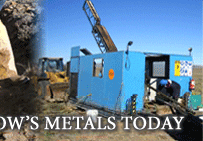Toronto, ON, November 26, 2004 ? Argentex Mining Corporation (OTCBB: AGXM) is pleased to provide an update on its properties in Santa Cruz and Rio Negro, strategically positioned in southern Argentina?s Patagonia region.Through systematic exploration during its preliminary work -- which began in March 2004 and is ongoing -- the company has reached significant milestones in the development of its gold-silver properties.
?Significant new discoveries have been made within our property portfolio and we believe there is the potential for a major discovery with continued effort,? stated Ken Hicks, Vice President of Exploration for Argentex.
SANTA CRUZ PROVINCE
Pinguino
A property-wide prospecting program at Pinguino in Santa Cruz province has confirmed more than 15 miles (25 kilometers) of mineralized vein system contained in multiple zones, the largest of which is the Marta vein system. To date, Argentex has conducted selected trench sampling of existing trenches, testing 20 of the 155 open trenches from the previous operator.Results from the spring 3D IP geophysical program have been received and they confirm an extensive depth potential of the Marta vein system.Soil geochemistry has also proven to be an excellent indicator of blind or covered veins, undiscovered in the previous exploration history, and trenching continues to expose more of the mineralized vein system.
This Phase 1 exploration program collected more than 200 diamond saw channel samples from 20 of the 155 existing trenches on the property. Large widths of silver-gold mineralization were encountered, including:
|
Trench TM 74 with 27.6 feet of 0.07 oz/t Au and 9.55 oz/t Ag or 0.23 oz/t gold equivalent; |
|
Trench TY 18 with 3.9 feet of 0.27 oz/t Au and 10.90 oz/t Ag or 0.45 oz/t Au equivalent; |
|
Trench TM 136 with 7.5 feet of trace gold and 182.68 oz/t Ag or approximately 3.0 oz/t Au equivalent. . |
A silver:gold ratio of 60:1 is used for the calculation of gold equivalency.There appears to be at least two distinct styles of mineralization, including gold-silver combined and high grade silver.
More than 1,000 soil samples were collected in a tight grid pattern over existing vein exposure and beyond into areas covered by a thin overburden.Results reveal excellent gold-silver correlation with existing veins and the discovery of ?blind? vein structures not obvious during prospecting.
Also during Phase 1, 24 line miles (38.5 line kilometers) of 3D IP geophysics were completed over significant segments of the Marta vein system.Results received from the independent geophysical contractor show a good correlation with gold-silver mineralization exposed in the trenches as well as a considerable depth extension and continuity of the favorable structure in excess of 650 feet (200 meters).
Phase 2 exploration is continuing at Pinguino, where more than 170 new trenches have been excavated. A magnetometer survey is in progress and additional fill-in and reconnaissance soil samples are being collected. The exploration target is additional subsidiary veins which might be covered by a thin overburden.
In summary, the geochemistry and geophysical work completed to date at Pinguino has generated a large number of excellent drill targets for the upcoming diamond drill program in early 2005.Prospecting continues to generate new discoveries and resampling of existing trenches has returned good surface values of gold-silver mineralization.3D IP geophysics has also revealed good depth potential and correlation with surface mineralization.
El Condor
Results from the 3.10 mile (5 kilometer) 3D IP geophysical survey at El Condor, also located in Santa Cruz province, have been received.This initial survey displayed large chargeability and resistivity anomalies below the surface mineralization, which contains visible gold. A small soil grid returned moderately anomalous precious metal values in widespread locations.
The Deseado Massif region is the center of activity for gold-silver exploration, development and active mining in Santa Cruz province. Mineralization is most commonly in the form of narrow (usually <30 feet) but extremely rich quartz veins which provide a high value per ton of ore. Argentex holds mineral rights to 12 properties totaling 175,000 acres (70,820 hectares) in Santa Cruz. Of these holdings, Pinguino is the most advanced in terms of exploration work carried out to date. With only a relatively small portion of the property having been tested, it has returned excellent gold-silver values from its trenches and shows good potential for additional discoveries in the future.
RIO NEGRO PROVINCE
Extensive property work continues to generate new epithermal vein discoveries and expand the known zones of visible gold within the first discovery area (announced on June 30, 2004).Two zones situated approximately 1,640 feet (500 meters) apart are known to contain visible gold with grab samples up to 4.63 oz/t gold (144 g/t gold).The discoveries are open in all directions and are within a large alteration zone dominated by silicified and jarositic felsic tuffs.
The Phase 2 exploration program at Rio Negro was completed in September. It focused on examining the extensive Argentex land position in the Los Menucos area with two objectives. The first was to follow-up on the previously reported gold discovery in which reconnaissance sampling of a newly discovered quartz vein returned gold assays ranging up to 0.13 oz/t Au.The discovery lies within a large hydrothermally altered zone which exceeds 0.6 square miles (one square kilometer), suggesting that gold mineralization might be widespread.
In the general area of known mineralization, an extensive control grid was established and geological mapping, soil sampling and geophysical tests were carried out.Over 1,000 soil samples and 45 rock samples were collected from within the grid.Geochemical anomalies in gold and pathfinder elements were found but they were low in magnitude.Prospecting, however, discovered a new quartz vein-breccia zone approximately 1,640 feet (500 meters) from the original discovery, containing abundant visible gold. Rock grab samples with gold values greater than 0.03 oz/t in the original MS-ICP analysis were reanalyzed with instructions to screen for metallic gold and carry out a standard fire assay. Assay results of 10 rocks samples returned gold values of 0.06, 0.06, 0.06, 0.09, 0.26, 0.31, 0.46, 1.02, 1.07, 4.62 oz/t Au, respectively.
Mapping traced out an additional two separate vein systems for 0.8 miles (1.3 kilometers) and 1.85 miles (3 kilometers), respectively. Grab samples from these vein systems returned anomalous values in pathfinder elements and precious metals.
A magnetometer survey was carried out on the soil grid area and initial results appear to show a positive correlation of magnetic lows and the exposed veins. Further interpretation is ongoing.
The second objective of the Rio Negro program was to continue reconnaissance work on the company?s outlying properties within the Los Menucos area.Argentex utilized its expanding knowledge of the region to target prospective areas of gold mineralization.
During regional prospecting of the other properties, two new epithermal style veins were discovered, with each being 1,640 feet (500 meters) in length.Quartz vein breccia, crustiform quartz layers and chalcedonic quartz were evident. Samples have been submitted for analysis and Argentex is awaiting the results.
Argentex holds mining rights to 18 properties totaling 170,000 acres (68,796 hectares) in Rio Negro province.Located in the Los Menucos Gold District, the area is still in the early exploration stages. This emerging gold field has a regional geological setting similar to the Deseado Massif in the Santa Cruz province and is believed to hold significant potential.
The company is currently seeking to increase its land portfolio in Rio Negro given the positive results received to date.
A summary of all results will be available on the Argentex website upon completion of the company?s 2004 exploration program, in mid-December, at http://www.argentexmining.com/.
All analytical work on rock and soil samples is carried out by Acme Analytical Labs in Santiago, Chile and Vancouver, Canada. Argentex carries out a thorough quality control and duplicate field sample procedure in their exploration work.
ABOUT ARGENTEX:
Argentex Mining Corporation is a junior mining exploration company with significant holdings in the Patagonia region of Argentina. The company currently owns mineral rights to 30 properties with over 345,000 acres (139,616 hectares) of highly prospective land, located in the Santa Cruz and Rio Negro provinces of Argentina. The company trades under the symbol AGXM on the OTCBB.
FURTHER INFORMATION:
Argentex Mining Corporation
Investor Relations
1-888-601-8366
[email protected]
Information Regarding Forward-Looking Statements: Except for historical information contained herein, the statements in this Press Release are forward-looking statements that are made pursuant to the safe harbor provisions of the Private Securities Litigation Reform Act of 1995. Forward-looking statements involve known and unknown risks and uncertainties, which may cause Argentex's actual results in future periods to differ materially from forecasted results. These risks and uncertainties include, among other things, volatility of commodity prices, product demand, market competition, and risks inherent in Argentex's operations. These and other risks are described in the Company's Annual Report on Form 10-K and other filings with the Securities and Exchange Commission.
Cautionary Note to US Investors: This news release may contain information about adjacent properties on which we have no right to explore or mine. We advise U.S. investors that the SEC's mining guidelines strictly prohibit information of this type in documents filed with the SEC. U.S. investors are cautioned that mineral deposits on adjacent properties are not indicative of mineral deposits on our properties. This news release may contain forward-looking statements including but not limited to comments regarding the timing and content of upcoming work programs, geological interpretations, receipt of property titles, potential mineral recovery processes, etc. Forward-looking statements address future events and conditions and therefore involve inherent risks and uncertainties. Actual results may differ materially from those currently anticipated in such statements.









